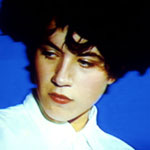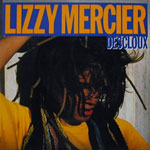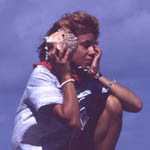
“Riot of january, record in the city wrecked by the sea, chanting streets, papilla de samba … Remember! Never collapse always dazzle!!”
sleevenotes to One For The Soul 1985
And this time let’s play it straight. For once, it’s important not to wander off at tangents. Lizzy was one of the great pop figures, and she left us far too soon. She left us just as her earliest work was being salvaged. Lizzy was always several steps ahead of the game.
Her good friend Richard Hell wrote movingly just a few days after her death in April 2004. He acknowledged that she was the inspiration for his character Chrissa in the novel Go Now, and he went on to quote a passage from the book based on the first few weeks he knew her. I love a lot of Richard Hell’s words, but I like these ones more than most.
“She was little, with matted hair … She was a spectacle: carnivore and prey in one, like a walking wildlife film, with that riveting amoral charisma of nature. A complete mystery. At 17 she was more sophisticated than anyone I’d ever known, while also seemingly utterly unaffected. Or at least her affectations came from such a stubborn confidence and will to defy convention that they were irresistible …”
Lizzy with long term soul mate Michel Esteban (who Hell was less gracious about) came to downtown New York initially in 1976 to check out the new wave. Hanging out with Hell and others on the scene, Lizzy found her spiritual home, and was captured for posterity shooting the Heartbreakers as part of Amos Poe’s primitive proto-punk Blank Generation film. Hell used a video grab from the film showing himself with Lizzie to illustrate his moving farewell.

Lizzy and Michel would return to New York a couple of years later, and immerse themselves in the creative revolution taking place as the new wave morphed into the no wave. Positioned as Patti’s protégé Lizzy’s activity included inventing the Rosa Yemen identity, which was something almost unique even among the savagery of the no wave community. Lizzy’s direction was more measured, with the guitars needling and wheedling, and words a torrent of mad meshing ideas. Michel provided an outlet for the unprecedented music via the nascent Ze label. In Zigzag Clash comrade Robin Banks said of the Rosa Yemen EP: “It’s spine-chilling, breathtaking and stunning in its simplicity and beauty.”
Adding pioneering Parisian punk (from Marie et les Garcons) Erik Eliasson to the outfit Lizzie worked away in the famed Blank Studios in early 1979 creating the wonderful Press Color set, one of the first successful attempts to fuse punk chaos with the underground disco sounds. Interestingly while Lizzie wrestled with Lalo Schiffrin soundtracks and using inability to create made musical miscegenations on the other side of the Atlantic kindred spirits like Steve Walsh and Manicured Noise were dancing along similar tightropes.
And this was at a time when Ze was ineffably cool and absurdly glamorous. Lizzy and Cristina were the queens of New York, Lydia Lunch and James Chance were hell bent on destruction, the Garcons reinvented French disco and Kid Creole was going to reinvent the spectacle of musicals. Reading about it all in magazines like Zigzag and The Face was like glimpsing into a different, unattainable world. And some people wanted still to walk around in leather jackets and studs.
What Lizzie did next was relocate to funky Nassau, and put together the most madcap and exuberant collection of rhythms and ideas at what would become the famed Compass Point studios. The resulting Mambo Nassau set is easily one of my favourite records ever, and its boisterousness and brattishness make distant cousins like the Slits, Tom Tom Club, Raincoats, and Essential Logic seem particularly prim and pedestrian. Perhaps only Davy Henderson’s imagination has the wherewithal to keep pace, and certainly dare to match creations like 'Lady O K’pele' and 'Sports Spootnicks'.

Interestingly Lizzie’s Ze colleagues struggled to develop. Lydia became a wonderful pantomime act. James Chance never moved on from that punk funk showstopping turn. Kid Creole became a cartoon. Cristina would stubbornly deprive us of waspish wisdom after the wonders of Sleep It Off. But Lizzy was still soaring ahead and searching. Of all the rhythms she hijacked the particular passion was the incredible music coming out of the African continent.
Typically while most forward thinking music obsessives made do with the occasional record, via Rough Trade or Oval, John Peel or Charlie Gillett, or any local equivalent outlet, Lizzie wholeheartedly immersed herself in an African adventure, finally landing in South Africa (and remember this was still during the hateful apartheid days) to record with local township musicians the Zulu Rock set, which very much in the spirit of the African sounds of the time seemed to throw everything into the mix, long before the derisory term of world music was let loose upon us. And Lizzie got CBS to fund this wonderful folly, and the people of France to buy the thing while we in England were blissfully ignorant of it all going on.
Lizzie’s plan then was to move the carnival onto New Orleans, take her Soweto comrades with her into the bayou country, and create a new swamp music for the heart of Saturday night, and anyone just thinking about it can see the link between the Cajun sound and African highlife. It could have been perfect, but there were bureaucratic practicalities too difficult to overcome. So instead Lizzie and Michel headed south to Rio, where the One For The Soul set was graced by doomed romantic Chet Baker in a kind of perfect symbolism. The producer was Adam Kidron, who was at the controls for many of the most important releases of the early 1980s.

Lizzie’s last official set would be the 1988 Suspense set, produced by John Brand (of Magazine, Go-Betweens, and Hurrah! fame) and Mark Cunningham, an old no wave compatriot from Mars, and featuring an unexpected tribute to fellow Hurricane, the cantankerous snooker player Alex Higgins. While some of the production is rather of its time, the set contains my very favourite Lizzy song, the very beautiful ballad 'The Long Goodbye', where the possibilities are stretched by the irregularity of the French enunciation, and you’re left wondering …
Lizzy chose to leave pop behind for other activities, like writing and painting. And even to this there is an almost too perfect elegance and mystique. So often the performer lumbers on with diminishing returns, and the obsessive fan searches for pearls and truffles, making excuses. The initial appeal of the New Wave/No Wave milieu was the flurry of activity in so many different areas of the arts. Some painting here. Some poetry there. A bit of experimental film. A lot of cathartic noise. Theatrics and photography. Design and improvisation. A book on the go. A collage on the wall.
And Ze was the perfect label for those times. A label Michel Esteban recalled spectacularly to life in 2003, with Lizzy’s earliest recordings among the first of the beautifully packaged reissues (with the sleevenotes in her own words). The timing was so right and so wrong. As Michel put it himself:
Back from a trip to New York in April 2003, she was diagnosed with cancer. She left us in April 2004, right by the sea in the tiny port of Saint Florent, Corsica, where she had chosen to end her days. According to her wishes, her ashes were scattered in the sea, which she felt to be her second home. Believe it or not, two dolphins appeared near the boat and accompanied the ashes, mingled with the petals of wild flowers, far out to sea, as far as where the dividing currents part ways to Spain and Italy. She rarely dropped anchor in life and now, at last, she is sailing free forever.”
© 2006 John Carney